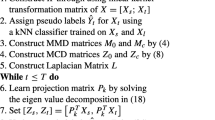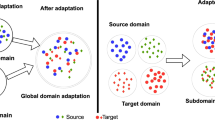Abstract
Unsupervised domain adaptation (UDA) serves to transfer specific knowledge from massive labeled source domain data to unlabeled target domain data via mitigating domain shift. In this paper, we propose a discriminative relevance regularization term (DRR) to enhance the performance of UDA by reducing the domain shift from the aspect of semantic relevance across domains. In particular, DRR is formulated as the min–max rank problem which seeks a projection matrix to minimize the rank of intra-class projected features and maximize the rank of the means of inter-class projected features simultaneously. To test the potential effectiveness of DRR, we design a relevance regularized distribution adaptation method (RRDA) and relevance regularized adaptation networks (RRAN) for image classification, and a relevance regularized self-supervised learning method (RRSL) for semantic segmentation by incorporation of DRR. The corresponding optimization algorithms are proposed to solve them. Experiments of cross-domain image classification show that both RRDA and RRAN outperform several state-of-the-art compared methods. Moreover, experiments of domain-adaptation semantic segmentation on two synthetic-to-real segmentation datasets demonstrate the capacity of RRSL. Such results imply the efficacy of DRR on both image classification and semantic segmentation tasks.





Similar content being viewed by others
References
Bousmalis K, Silberman N, Dohan D, Erhan D, Krishnan D (2017) Unsupervised pixel-level domain adaptation with generative adversarial networks. In: IEEE conference on computer vision and pattern recognition. pp 95–104
Chen LC, Papandreou G, Kokkinos I, Murphy K, Yuille AL (2017) Deeplab: semantic image segmentation with deep convolutional nets, atrous convolution, and fully connected crfs. IEEE Trans Pattern Anal Mach Intell 40(4):834–848
Chen M, Xue H, Cai D (2019) Domain adaptation for semantic segmentation with maximum squares loss. In: IEEE international conference on computer vision. pp 2090–2099
Cordts M, Omran M, Ramos S, Rehfeld T, Enzweiler M, Benenson R, Franke U, Roth S, Schiele B (2016) The cityscapes dataset for semantic urban scene understanding. In: IEEE conference on computer vision and pattern recognition. pp 3213–3223
Donahue J, Jia Y, Vinyals O, Hoffman J, Zhang N, Tzeng E, Darrell T (2014) Decaf: A deep convolutional activation feature for generic visual recognition. In: International conference on machine learning. pp 647–655
Fazel M (2002) Matrix rank minimization with applications. Ph.D. thesis, Stanford University
Fisher RA (1936) The use of multiple measurements in taxonomic problems. Ann Humn Genet 7(2):179–188
Ganin Y, Lempitsky V (2015) Unsupervised domain adaptation by backpropagation. In: International conference on machine learning. pp 1180–1189
Ganin Y, Ustinova E, Ajakan H, Germain P, Larochelle H, Laviolette F, Marchand M, Lempitsky V (2016) Domain-adversarial training of neural networks. J Mach Learn Res 17(1):2030–2096
Ghifary M, Balduzzi D, Kleijn WB, Zhang M (2015) Scatter component analysis: a unified framework for domain adaptation and domain generalization. IEEE Trans Pattern Anal Mach Intell 39(7):1414–1430
Glorot X, Bordes A, Bengio Y (2011) Domain adaptation for large-scale sentiment classification: a deep learning approach. In: International conference on machine learning. pp 513–520
Gong B, Grauman K, Sha F (2013) Connecting the dots with landmarks: discriminatively learning domain-invariant features for unsupervised domain adaptation. In: International conference on machine learning. pp 222–230
Gong B, Shi Y, Sha F, Kristen G (2012) Geodesic flow kernel for unsupervised domain adaptation. In: IEEE conference on computer vision and pattern recognition. pp 2066–2073
Gong M, Zhang K, Liu T, Tao D, Glymour C, Schölkopf B (2016) Domain adaptation with conditional transferable components. In: International conference on machine learning. pp 2839–2848
Grave E, Obozinski G, Bach F (2011) Trace lasso: a trace norm regularization for correlated designs. In: International conference on neural information processing systems. pp 2187–2195
Gretton A, Borgwardt KM, Rasch MJ, Schölkopf B, Smola A (2012) A kernel two-sample test. J Mach Learn Res 13:723–773
Gretton A, Smola A, Huang J, Schmittfull M, Borgwardt K, Schölkopf B (2009) Covariate shift by kernel mean matching. In: Dataset shift in machine learning. pp 131–157
Griffin G, Holub A, Perona P (2007) Caltech-256 object category dataset. California Institute of Technology
He K, Zhang X, Ren S, Sun J (2016) Deep residual learning for image recognition. In: IEEE conference on computer vision and pattern recognition. pp 770–778
Hoffman J, Tzeng E, Park T, Zhu JY, Isola P, Saenko K, Efros AA, Darrell T (2017) Cycada: Cycle-consistent adversarial domain adaptation. arXiv preprint arXiv:1711.03213
Hoffman J, Wang D, Yu F, Darrell T (2016) Fcns in the wild: pixel-level adversarial and constraint-based adaptation. arXiv preprint arXiv:1612.02649
Hsieh Y, Tao S, Tsai YH, Yeh Y, Wang YF (2016) Recognizing heterogeneous cross-domain data via generalized joint distribution adaptation. In: IEEE international conference on multimedia and expo. pp 1–6
Hsu TH, Chen W, Hou C, Tsai YH, Yeh Y, Wang YF (2015) Unsupervised domain adaptation with imbalanced cross-domain data. In: IEEE international conference on computer vision. pp 4121–4129
Huang J, Smola AJ, Gretton A, Borgwardt KM, Schölkopf B (2006) Correcting sample selection bias by unlabeled data. In: Advances in neural information processing systems. pp 601–608
Isola P, Zhu JY, Zhou T, Efros AA (2017) Image-to-image translation with conditional adversarial networks. In: IEEE conference on computer vision and pattern recognition. pp 1125–1134
Krizhevsky A, Sutskever I, Hinton GE (2012) Imagenet classification with deep convolutional neural networks. In: Advances in neural information processing systems. pp 1097–1105
Li Y, Yuan L, Vasconcelos N (2019) Bidirectional learning for domain adaptation of semantic segmentation. In: IEEE conference on computer vision and pattern recognition. pp 6936–6945
Liu T, Tao D (2015) Classification with noisy labels by importance reweighting. IEEE Trans Pattern Anal Mach Intell 38(3):447–461
Liu T, Yang Q, Tao D (2017) Understanding how feature structure transfers in transfer learning. In: International joint conference on artificial intelligence. pp 2365–2371
Long J, Shelhamer E, Darrell T (2015) Fully convolutional networks for semantic segmentation. In: IEEE conference on computer vision and pattern recognition. pp 3431–3440
Long M, Cao Y, Wang J, Jordan M (2015) Learning transferable features with deep adaptation networks. In: International conference on machine learning. pp 97–105
Long M, Wang J, Ding G, Sun J, Yu PS (2014) Transfer feature learning with joint distribution adaptation. In: IEEE international conference on computer vision. pp 2200–2207
Long M, Zhu H, Wang J, Jordan MI (2016) Unsupervised domain adaptation with residual transfer networks. In: Advances in neural information processing systems. pp 136–144
Long M, Zhu H, Wang J, Jordan MI (2017) Deep transfer learning with joint adaptation networks. In: International conference on machine learning. pp 2208–2217
Luo Y, Liu T, Tao D, Xu C (2014) Decomposition-based transfer distance metric learning for image classification. IEEE Trans Image Process 23(9):3789–3801
Luo Y, Wen Y, Liu T, Tao D (2018) Transferring knowledge fragments for learning distance metric from a heterogeneous domain. IEEE Trans Pattern Anal Mach Intell 41(4):1013–1026
Luo Y, Zheng L, Guan T, Yu J, Yang Y (2019) Taking a closer look at domain shift: Category-level adversaries for semantics consistent domain adaptation. In: IEEE conference on computer vision and pattern recognition. pp 2507–2516
Oquab M, Bottou L, Laptev I, Sivic J (2014) Learning and transferring mid-level image representations using convolutional neural networks. In: IEEE conference on computer vision and pattern recognition. pp 1717–1724
Pan SJ, Tsang IW, Kwok JT, Yang Q (2011) Domain adaptation via transfer component analysis. IEEE Trans Neural Netw 22(2):199–210
Pan SJ, Yang Q (2010) A survey on transfer learning. IEEE Trans Knowl Data Eng 22(10):1345–1359
Pei Z, Cao Z, Long M, Wang J (2018) Multi-adversarial domain adaptation. In: AAAI conference on artificial intelligence
Radford A, Metz L, Chintala S (2015) Unsupervised representation learning with deep convolutional generative adversarial networks. arXiv preprint arXiv:1511.06434
Richter SR, Vineet V, Roth S, Koltun V (2016) Playing for data: ground truth from computer games. In: European conference on computer vision. Springer, pp 102–118
Ros G, Sellart L, Materzynska J, Vazquez D, Lopez AM (2016) The synthia dataset: A large collection of synthetic images for semantic segmentation of urban scenes. In: IEEE conference on computer vision and pattern recognition. pp 3234–3243
Saenko K, Kulis B, Fritz M, Darrell T (2010) Adapting visual category models to new domains. In: European conference on computer vision. pp 213–226
Shao L, Zhu F, Li X (2015) Transfer learning for visual categorization: a survey. IEEE Trans Neural Netw Learn Syst 26(5):1019–1034
Si S, Tao D, Geng B (2010) Bregman divergence-based regularization for transfer subspace learning. IEEE Trans Knowl Data Eng 22(7):929–942
Simonyan K, Zisserman A (2014) Very deep convolutional networks for large-scale image recognition. arXiv preprint arXiv:1409.1556
Sun B, Feng J, Saenko K (2015) Return of frustratingly easy domain adaptation. In: AAAI conference on artificial intelligence. pp 2058–2065
Tsai YH, Hung WC, Schulter S, Sohn K, Yang MH, Chandraker M (2018) Learning to adapt structured output space for semantic segmentation. In: IEEE conference on computer vision and pattern recognition. pp 7472–7481
Tzeng E, Hoffman J, Saenko K, Darrell T (2017) Adversarial discriminative domain adaptation. In: IEEE conference on computer vision and pattern recognition. pp 2962–2971
Tzeng E, Hoffman J, Zhang N, Saenko K, Darrell T (2014) Deep domain confusion: maximizing for domain invariance. arXiv preprint arXiv:1412.3474
Vu TH, Jain H, Bucher M, Cord M, Pérez P (2019) Advent: Adversarial entropy minimization for domain adaptation in semantic segmentation. In: IEEE conference on computer vision and pattern recognition. pp 2517–2526
Wang K, He R, Wang W, Wang L, Tan T (2013) Learning coupled feature spaces for cross-modal matching. In: IEEE international conference on computer vision. pp 2088–2095
Wang M, Deng W (2018) Deep visual domain adaptation: a survey. Neurocomputing 312:135–153
Wu X, Song L, He R, Tan T (2018) Coupled deep learning for heterogeneous face recognition. In: AAAI conference on artificial intelligence
Wu Z, Han X, Lin YL, Gokhan Uzunbas M, Goldstein T, Nam Lim S, Davis LS (2018) Dcan: Dual channel-wise alignment networks for unsupervised scene adaptation. In: European conference on computer vision (ECCV). pp 518–534
Xie J, Kiefel M, Sun MT, Geiger A (2016) Semantic instance annotation of street scenes by 3d to 2d label transfer. In: IEEE Conference on computer vision and pattern recognition. pp 3688–3697
Yang Y, Hospedales TM (2017) Trace norm regularised deep multi-task learning. In: International conference on learning representations workshop
Yosinski J, Clune J, Bengio Y, Lipson H (2014) How transferable are features in deep neural networks? In: Advances in neural information processing systems. pp 3320–3328
Yu X, Liu T, Gong M, Zhang K, Batmanghelich K, Tao D (2017) Transfer learning with label noise. arXiv preprint arXiv:1707.09724
Zhang J, Li W, Ogunbona P (2017) Joint geometrical and statistical alignment for visual domain adaptation. In: IEEE conference on computer vision and pattern recognition. pp. 5150–5158
Zhang Y, David P, Gong B (2017) Curriculum domain adaptation for semantic segmentation of urban scenes. In: Proceedings of the IEEE international conference on computer vision. pp 2020–2030
Zhang Y, Yeung DY (2010) Transfer metric learning by learning task relationships. In: ACM international conference on knowledge discovery and data mining. pp 1199–1208
Zhao H, Shi J, Qi X, Wang X, Jia J (2017) Pyramid scene parsing network. In: IEEE conference on computer vision and pattern recognition. pp 2881–2890
Zou Y, Yu Z, Liu X, Kumar B, Wang J (2019) Confidence regularized self-training. arXiv preprint arXiv:1908.09822
Zou Y, Yu Z, Vijaya Kumar B, Wang J (2018) Unsupervised domain adaptation for semantic segmentation via class-balanced self-training. In: European conference on computer vision (ECCV). pp 289–305
Acknowledgements
This work was supported by the National Natural Science Foundation of China [61806213, 61702134, 61906210].
Author information
Authors and Affiliations
Corresponding author
Additional information
Publisher's Note
Springer Nature remains neutral with regard to jurisdictional claims in published maps and institutional affiliations.
Rights and permissions
About this article
Cite this article
Zhang, W., Zhang, X., Lan, L. et al. Enhancing unsupervised domain adaptation by discriminative relevance regularization. Knowl Inf Syst 62, 3641–3664 (2020). https://doi.org/10.1007/s10115-020-01466-z
Received:
Revised:
Accepted:
Published:
Issue Date:
DOI: https://doi.org/10.1007/s10115-020-01466-z




